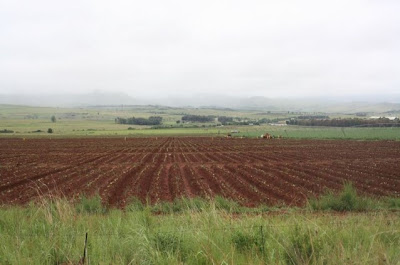The South Africa that M and I started our married life in was vastly different from the cosy, colonial outpost that I had left twelve years previously when I joined my mother in the US. The country's independence from the UK had come in 1961, just two years before I left for America. Many of the changes were subtle, not obvious to the casual observer but the pendulum had swung and there was no going back. What was not immediately apparent was that the country I had longed for was already gone.
We married in January 1976 in Johannesburg and set up home on M’s farm some 60 miles to the east, on the savannah of the old Transvaal highveld (present day Mpumalanga). His family had been on this land since 1907 and owned an estate measured in miles rather than acres. This was divided into seven family farms of roughly the same size. Each farm was owned by one of M’s relatives, his father having the original manor house to the south/east of us and M’s younger brother farming to the north/west; the remaining five properties were occupied by cousins, great-uncles and uncles.
Our first home was a simple, whitewashed, two–room cottage with no electricity and a ‘Donkey’ (44 gallon drum) boiler for hot water. Tucked away in the gentle folds of low-lying hills, the cottage had been built in a small, flat, hidden valley; surrounded by dams, protected by eucalyptus windbreaks and dotted with weeping willows. Wildlife was abundant with small buck, jackals, foxes, rabbits and bird-life attracted by the water and the shelter of the trees. The building dated back to the early years of the Witwatersrand gold rush and was very basic, although M had installed running water and a bathroom but that was the extent of the modernisation! Without electricity, there were few 20th century distractions, we lived a fairy-tale life; meals were cooked on gas or over the open fire in the boma and after the lamps had been lit, evenings were spent reading or painting. I sewed my quilts and patchwork on an old-fashioned treadle Singer sewing machine and the modern world was far away. Life was simple and we loved it. The farm had been used for raising mealies (white corn) and sunflower for many years and M was busy turning some fields into Teff and Eragrostis pastures to provide fodder for the robust Johannesburg horse racing industry. These crops were planted and then cut two or three times in a season to be baled and stored for sale in the winter when the need was greater and prices were higher.

An Mpumalanga Farm - like ours
Having a farm meant labour and not only male labour. I was soon putting in a long day driving our Jeep; towing the trailer behind M’s tractor as he baled the feed, cut early that morning. The workers would walk alongside using pitchforks to load the bales up onto the trailer where another worker would pack them neatly. Often we would find ourselves locked in a desperate race with the weather as we fought to get the morning’s cut off the lands before a highveld thunderstorm ruined the quality of our product. It was hard work and intensely satisfying after my seemingly superficial life in Los Angeles; this was elemental living, close to nature, and when dusk came we would sit on our stoep (veranda), drinking a glass of wine, and watch the birds come in to roost in the willow trees overhanging the dam. But it wasn't all mud and dust and toil; every six weeks or so we’d head for the bright lights and malls of Johannesburg and spend a day shopping, not just foodstuffs but real retail therapy. The cottage needed all sorts of domestic paraphernalia and after a long and lazy lunch, we would spend time exploring the shops for bits and pieces. These small breaks gave us our necessary dose of modern civilisation - and the big smoke - but I don’t know if we really appreciated the extent to which we had “the best of both worlds”!
Life changed dramatically with the arrival of our first son toward the end of 1977 and we prepared to leave our little cottage and move to the main homestead on our farm, nearly two miles up the hill. This large farmhouse was a basic ‘40’s dwelling, well built, solid and ‘oh so dull’ with electricity and full plumbing but no charm. To bring electricity from the local substation and have the cottage wired was prohibitively expensive and sad preparations to move began. We left behind our little, traditional style house with its wooden windows and doors, Oregon pine floors and long stoep. We said goodbye to the green lawns sweeping down to the willows by the dams and fountains, and left our boma* with the sandy floor. Although we couldn’t have known it at the time, we had said goodbye to the Africa we loved.
* A boma (pronounced 'boom-a' by local tribes. Not 'bowma' is some people say it) is a circular enclosure of reeds, heavy grass or thorn bush, made for people to eat and sleep in. An entry point is started on the outside of the circle and continues for some distance until it opens into the enclosure, forming a narrow corridor which is then closed with Thorn-tree branches to keep predators out. Livestock was traditionally housed in a similar structure known as a goma ('goom-a').
